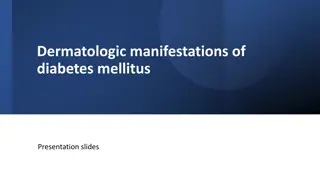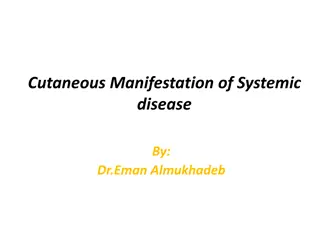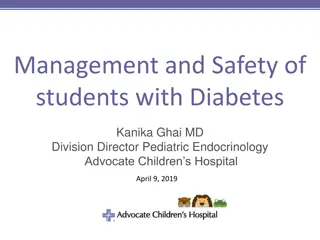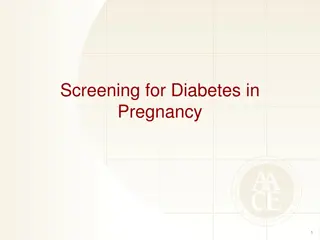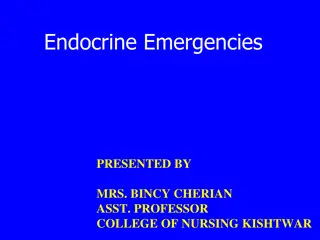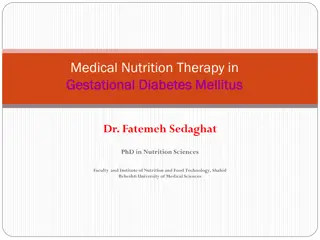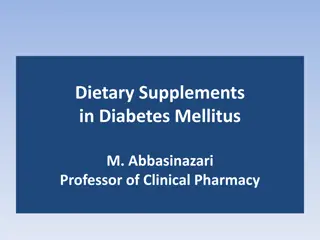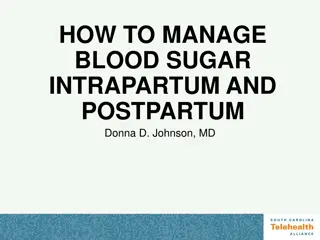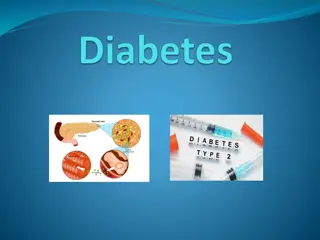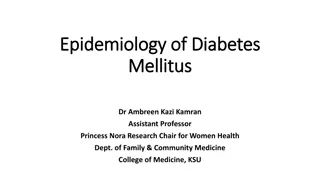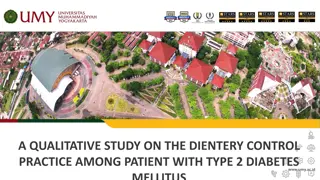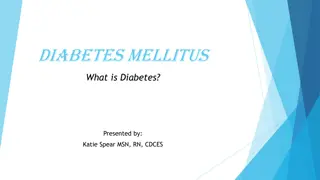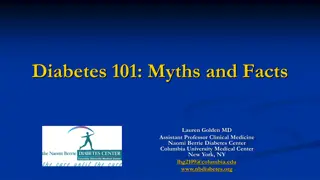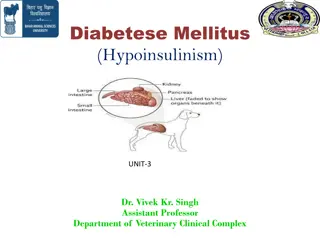Understanding Gestational Diabetes Mellitus
Gestational Diabetes Mellitus (GDM) is a condition of glucose intolerance in pregnancy, characterized by hyperglycemia. It poses risks to both mother and baby, including macrosomia, birth trauma, neonatal complications, and long-term complications. The diagnosis of GDM involves criteria set by WHO in 1999, but challenges exist due to varying glucose cutoffs. Understanding and managing GDM is crucial for optimal pregnancy outcomes.
Download Presentation

Please find below an Image/Link to download the presentation.
The content on the website is provided AS IS for your information and personal use only. It may not be sold, licensed, or shared on other websites without obtaining consent from the author. Download presentation by click this link. If you encounter any issues during the download, it is possible that the publisher has removed the file from their server.
E N D
Presentation Transcript
Diabetes is defined as a syndrome of multiple ( ( inherited hyperglycaemia with disturbances of carbohydrate, fat and protein metabolism due to deficient action of insulin on target secretion, insulin resistance or both) WHO, 1999. Diabetes is defined as a syndrome of multiple aetiology inherited or acquired ) hyperglycaemia with disturbances of carbohydrate, fat and protein metabolism due to deficient action of insulin on target tissues ( resulting secretion, insulin resistance or both) WHO, 1999. aetiology or acquired ) characterized by chronic characterized by chronic tissues ( resulting from inadequate insulin from inadequate insulin 2
Diabetes mellitus in pregnancy (DIP) and Gestational Diabetes mellitus (GDM) is hyperglycaemia detected any time in pregnancy. 3
MATERNAL: Birth trauma Pelvic injuries, PPH, Fistulae Caesarean Section complications PPH, iatrogenic injuries Hypertensive disorders in pregnancy Pre- eclampsia Anaesthetic complications Sepsis Depression Maternal mortality 5
Macrosomia, Neonatal admission, Congenital abnormalities, LGA births, Birth trauma, Hyperbilirubinemia, Shoulder dystocia, Respiratory distress syndrome, SGA births, Neonatal hypoglycemia, Preterm births, Diabetes Later in Life and perinatal Mortality. 6
What is glucose intolerance in pregnancy? Dilemma WHO, 1999 attempted to answer this question with laid down criteria which was not diagnostic but prognostic. Dilemma (a) (b) Large numbers of procedures Large numbers of glucose cut offs. 7
Not evidence based Presence of new data (1999 is over 10 years) Fasting blood sugar of 7mmollL considered very high 8
TABLE 1: Most commonly used guidelines for the diagnosis of GDM Fasting Glucose 1-h plasma 3-h plasma 2-h plasma Organization Plasma Challenge Glucose Glucose Glucose Glucose 75g 0GTT 100g 0GTT WHO 1999(a) 7.0 Not required 7.8 Not required American congress obstetrician and Gynecologists(b) 5.3 10.0 8.6 7.8 of 75g0GTT Canadian Diabetes Association(c) 5.3 10.6 8.9 Not required IADPSG(d) 75g0GTT 5.1 10.0 8.5 Not required a) One value is sufficient for diagnosis b) Two or more values are required for diagnosis c) Two or more values required for diagnosis d) One value is sufficient for diagnosis 9
GDM - carbohydrate intolerance __ hyperglycemia __variable severity ___ onset or first recognition during pregnancy. 1st trimester / 1st half of second trimester the fasting and postprandial glucose concentrations are normally lower than in normal, non pregnant women, Hence, elevated levels may reflect diabetes antedating pregnancy. Criteria for detecting high glucose concentrations at this time are not established. Formal systemic testing for GDM is usually between 24 and 28 weeks of gestation. To determine presence of GDM, standard OGTT will be performed (fasting 8 14h, giving 75g anhydrous glucose in 250-300ml water). 10
WHO 2010 diagnosis and classification of glucose intolerance in pregnancy. WHO 2010 _____ expert group ____ Review definition, Recommendation 1 (CONSENSUS) : between Diabetes and lesser degree of glucose intolerance in pregnancy-by: not ____ significant risk of adverse perinatal outcome. are excluded from epidemiological and intervention studies. Recommendation 1 (CONSENSUS) : Distinguishing Diabetes in pregnancy, whether symptomatic or Pregnant women with more severe hyperglycemia is different. When detected early in pregnancy, management 11
1.) Distinguishing between Diabetes and GDM. 2.) Principles of management in both are similar, but there are differences in approaches (evidence based). Detailed assessment of presence of diabetes related complication ____retinopathy, renal impairment. Intensive monitoring and treatment of hyperglycemia in pregnancy. Follow-up of women and treatment after pregnancy. 12
RECOMMENDATION 2: DIP diagnosed by 2006 WHO criteria if one or more of the following criteria are met. Fasting plasma glucose 7.0 mmol/l (126mg/dl) 2-h plasma glucose 11.1 mmol/l (200mg/dl) following a 75g oral glucose load. Random plasma glucose 11.1 mmol/l (200mg/dl) in the presence of diabetes symptoms. NEW: Accepted universally in non-pregnant individuals, but in pregnancy these values are recorded as GDM. 13
RECOMMENDATION RECOMMENDATION 3 3: : GDM diagnosis at any time is based on any one of the following values. (180mg/dl) 199mgldl) Fasting plasma glucose =5.1-6.9mmol/l(92-125mgldl) 1-h post 75g oral glucose Load>=10.0mmol/l 2-h post 75g oral glucose load 8.5-11.0mmol/l (153- NOTE: Above definition of GDM applies at any time during pregnancy. However, in non obese pregnant women, FPG declines by about 0.5mmol/l(9mg/dl) by end of 1st trimester or early in the second. Hence, using cut off of 5.1mmol/l (92mg/dl) early in pregnancy may over diagnose GDM in non-obese women. However high first trimester FPG levels (but lower than those diagnostic of diabetes) are associated with increased risks of later diagnosis of GDM and adverse pregnancy outcome. 14
1) and classification of hyperglycemia first detected in pregnancy; A World Health Organization Guideline. Diabetes research and clinical practice 103 (2014) 341-363 Report of a World Health Organization consultation diagnostic criteria 2) consensus panel. International Association of Diabetes and Pregnancy Study groups recommendations on the diagnosis and classification of Diabetes Care 2010; 33 (3): 676-82. International Association of Diabetes and Pregnancy Study Group 3) et al. Hyperglycemia and adverse pregnancy outcomes. N Engl J. Med 2008;358(19): 1991-2002: Metzer BE, Lowe LP, Dyer AR, Trimble ER, Chaovarindr U, Coustan DR, 4) glucose intolerance on outcome of pregnancy. Surg Gynecol obstet 1990; 170(5): 427-36. Santini DL, Ales KL. The impact of universal screening for gestational 5) factors, perinatal complications and screening importance in Niger Delta Region of Nigeria: A public Health Dilemma International Journal of Tropical Disease and Health 2012; 2 (1):42-54. HAA UGBOMA, H Aburoma, P Ukaigwe Gestational Diabetes: Risk 15




